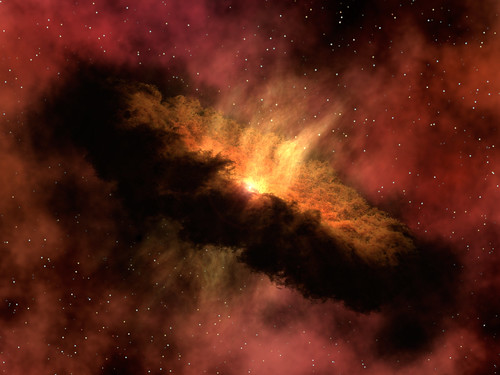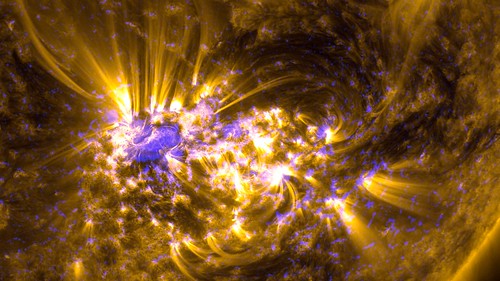Awesomeness Round-Up – 7/27/2012
- By Alexe Helmke
- July 27, 2012
- Comments Off on Awesomeness Round-Up – 7/27/2012
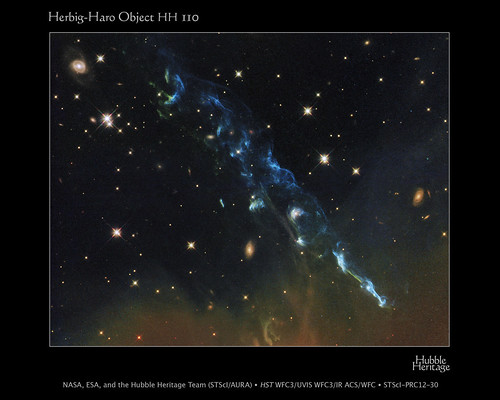
Credit: NASA, ESA, and the Hubble Heritage Team (STScI/AURA)
Hubble captured this wonderful image that looks very much like an outer space firework explosion. Herbig-Haro 110 is a geyser of hot gas being blown away from a newborn star that ricochets off the dense core of a cloud of molecular hydrogen. Herbig-Haro 110 is one of a collection of the group of Herbig-Haro objects that come in a variety of shapes, but still have the same basic configuration. Twin jets of heated gas are ejected out from a newly formed star and stream through the space between stars. Astronomers suspect that these jets are fueled by gas and dust falling onto a young star. The disk acts as the fuel tank, the star acts as the gravitational engine, and the jets are the exhaust. When these jets slam into the gas between stars, it heats up the gas, causing it to glow. Gas within the shock front slows dramatically, but more gas just keeps building up behind it, causing more glowing (These “bow shocks” are so names because they resemble the waves that form at the bow of a boat). By studying these structures carefully, astronomers can “rewind” them, in a way, in order to study the star’s history.

Credit: Credit: NASA, ESA, and T. Brown (STScI)
Hubble may have unmasked a mysterious and elusive kind of galaxy. Known as Ultra Faint Dwarf Galaxies, these ghostly galaxies are nearly star-less making them extremely difficult to detect. The mystery as to why these galaxies have so few stars has puzzled astronomers for a long time. These galaxies are thought to be some of the tiniest, oldest, and most pristine in the universe. They’ve been discovered over the past ten years by astronomers using automated computer techniques to search through the images of the Sloan Digital Sky Survey. But astronomers needed NASA’s Hubble Space Telescope to help solve the mystery of these star-starved galaxies. Thanks to Hubble, astronomers have been able to form a theory that the galaxies started forming their stars around 13 billion years ago (in the very young universe) and then suddenly stopped. But why?
The mostly likely explanation is a time in the universe’s history known as “reionization.” The reionization of the universe began in the first billion years after the big bang. During this epoch, radiation from the first stars knocked electrons off primeval hydrogen atoms, ionizing the cool hydrogen gas. The small irregular galaxies were born about 100 million years before reionization began and had just started to create their stars. The galaxies are the smaller cousins of the more luminous star-making dwarf galaxies near our Milky Way. Unlike their larger relatives, the puny galaxies were not massive enough to shield themselves from the harsh radiation during this violent radiation period in the early universe. What little gas they had was stripped away as the flood of light rushed through them. Their gas supply depleted, the galaxies could not make new stars. The Sloan survey recently uncovered more than a dozen of these star-starved galaxies in our Milky Way’s neighborhood while scanning just a quarter of the sky. Astronomers think the rest of the sky should contain dozens more of these tiny galaxies.
What’s more, these are some of the first galaxies to have formed in the universe, and they have remained virtually unchanged due to their lack of star formation. Another super interesting fact about these bitty galaxies is the amount of dark matter they appear to contain. Normal dwarf galaxies near the Milky Way contain 10 times more dark matter than the ordinary matter that makes up gas and stars. In these ultra-faint dwarf galaxies, dark matter outweighs ordinary matter by at least a factor of 100. Because these galaxies are mostly dark matter and have very few stars they have been very difficult to find and study, but they may hold more clues to the study of the very early universe.
Now you see it, now you don’t?
Astronomers have recently seen evidence that a large disk of dust surrounding the star called TYC 8241 2652 has mysteriously disappeared. The amount of dust that seems to have gone missing could fill an inner solar system, so how could have it just dissipated? Where did it go? The dusty disk – thought to be due to the collisions of forming planets – was first seen by the NASA Infrared Astronomical Satellite (IRAS) in 1983, and continued to glow brightly for 25 years. Then, in images taken by NASA’s Wide-field Infrared Survey Explorer (WISE) in January 2010 and at the Gemini telescope in Chile in 2012 confirm that the disk has not been there for at least two and a half years. Astronomers have come up with a couple possible solutions, but they say that none are truly compelling. So the mystery remains unsolved, for now.
An X1.4 class flare erupted from the surface of the sun, peaking on July 12, 2012 at 12:52 PM EDT. The flare originated from sunspot 1520. Sunspots are places of intense magnetic activity, where the sun’s magnetic field causes blobs of solar material to be held at the surface longer than normal. Occasionally, these sunspots will flare which can then sometimes release what is known as a “coronal mass ejection” (CME) which flings particles out from the surface of the sun. These flares are classified by their intensity and come in five classes: A, B, C, M, and X (A being the weakest and X being the strongest). The July 12 flare was X1.4 which says that is was very strong and it did release a coronal mass ejection in the direction of Earth.
CMEs consist of charged particles that have been thrown out from the sun in a solar flare. When these particles hit Earth’s atmosphere they do all sorts of interesting things. They can disrupt radio transmissions and interfere with some satellites, and they also tend to cause beautiful auroras, usually at higher latitudes. The flare on July 12 impacted the atmosphere of Earth over the July 14-15 weekend and was large enough to cause auroras to be reported as far south as Missouri and Arkansas.
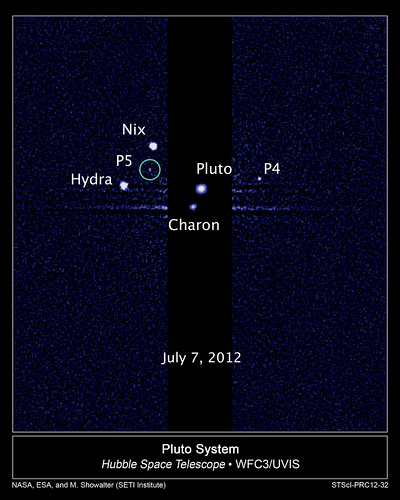
Credit: NASA; ESA; M. Showalter, SETI Institute
Hubble has discovered a fifth moon orbiting around the dwarf planet Pluto. The moon, creatively named P5 as of yet, is estimated to be irregular in shape and 6 to 15 miles across. It is in a 58,000-mile-diameter circular orbit around Pluto. Pluto’s largest moon, Charon, was discovered in 1978 in observations made at the United States Naval Observatory in Washington, D.C. Hubble observations in 2006 uncovered two additional small moons, Nix and Hydra. In 2011 another moon, P4, was found in Hubble data.
The Pluto team is intrigued that such a small object can have such a complex collection of satellites. The new discovery provides additional clues for unraveling how the Pluto system formed and evolved. The current favored theory is that all the moons are relics of a collision between Pluto and another large object in the outer solar system billions of years ago.
The new detection will help scientists navigate NASA’s New Horizons spacecraft through the Pluto system in 2015, when it makes an historic and long-awaited high-speed flyby of the distant world.
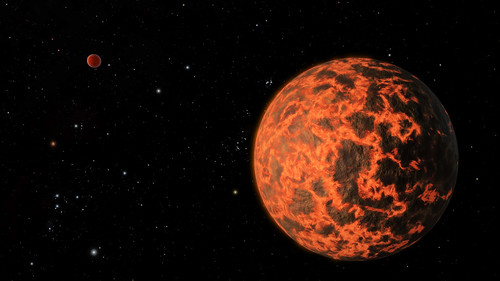
Credit: NASA/JPL-Caltech (Artist’s Concept)
NASA’s Spitzer telescope may have found an exoplanet even smaller than Earth! The exoplanet candidate, called UCF-1.01, is located a mere 33 light-years away, making it possibly the nearest world to our solar system that is smaller than our home planet. Spitzer has performed transit studies on known exoplanets, but UCF-1.01 is the first ever identified with the space telescope.
The planet candidate was found unexpectedly in Spitzer observations. Astronomers were studying the Neptune-sized exoplanet GJ 436b, already known to exist around the red-dwarf star GJ 436. In the Spitzer data, the astronomers noticed slight dips in the amount of infrared light streaming from the star, separate from the dips caused by GJ 436b. A review of Spitzer archival data showed the dips were periodic, suggesting a second planet might be orbiting the star and blocking out a small fraction of the star’s light. This technique, used by a number of observatories including NASA’s Kepler space telescope, relies on transits to detect exoplanets. The duration of a transit and the small decrease in the amount of light registered reveals basic properties of an exoplanet, such as its size and distance from its star. In UCF-1.01’s case, its diameter would be approximately 5,200 miles (8,400 kilometers), or two-thirds that of Earth and it would orbit far closer to its star than the planet Mercury is to our sun, the exoplanet’s surface temperature would be more than 1,000 degrees Fahrenheit. A surface temperature this high indicates that if the planet ever did have an atmosphere it has most likely evaporated. UCF-1.01 might therefore resemble a cratered, mostly geologically dead world like Mercury or could even have had its surface melted by it’s host star. More evidence is needed to officially confirm this body as an exoplanet, but so far things are looking good for UCF-1.01.


